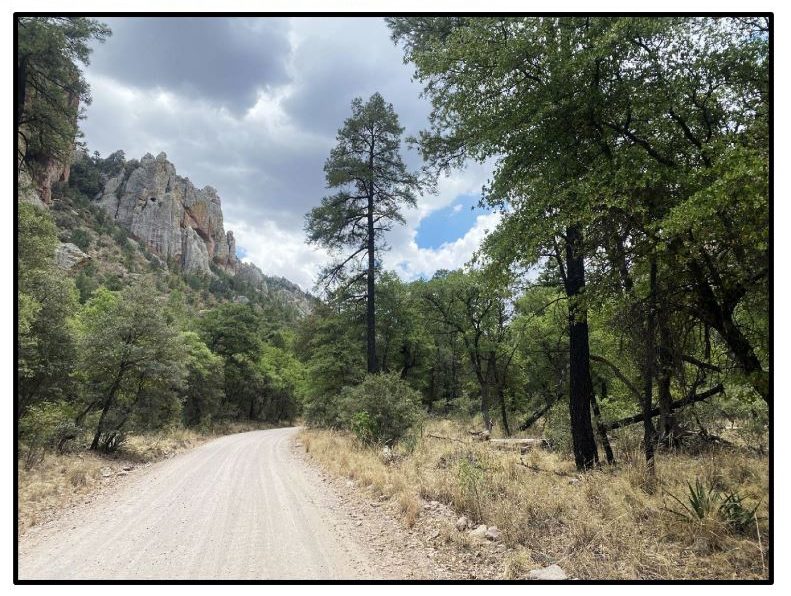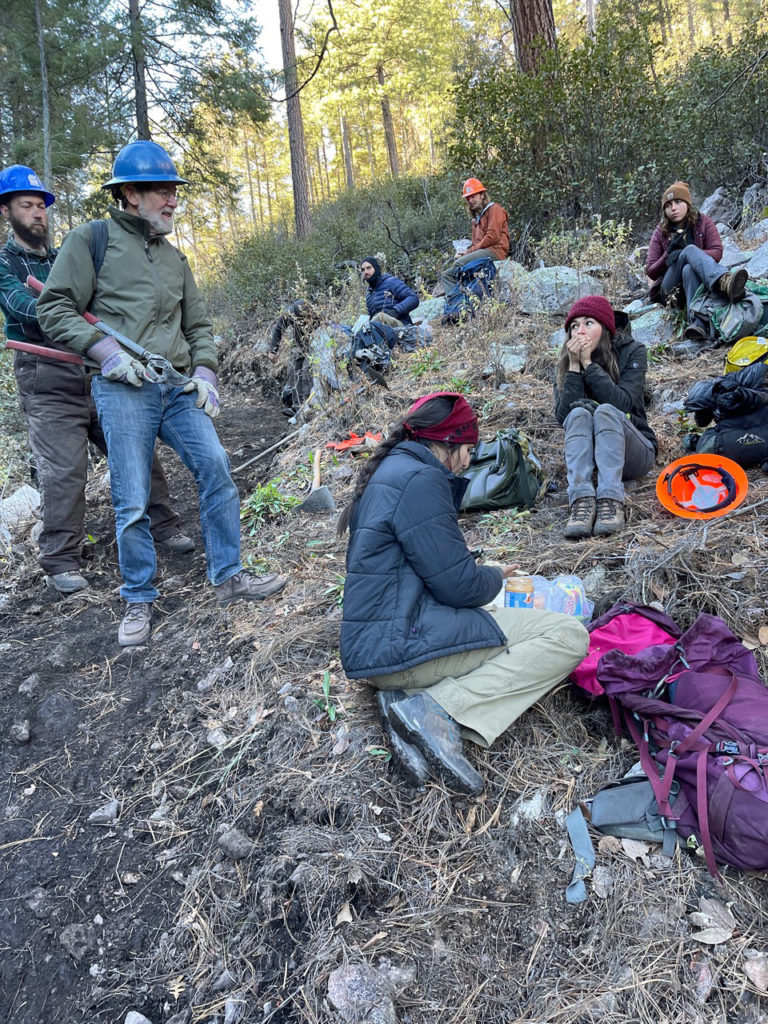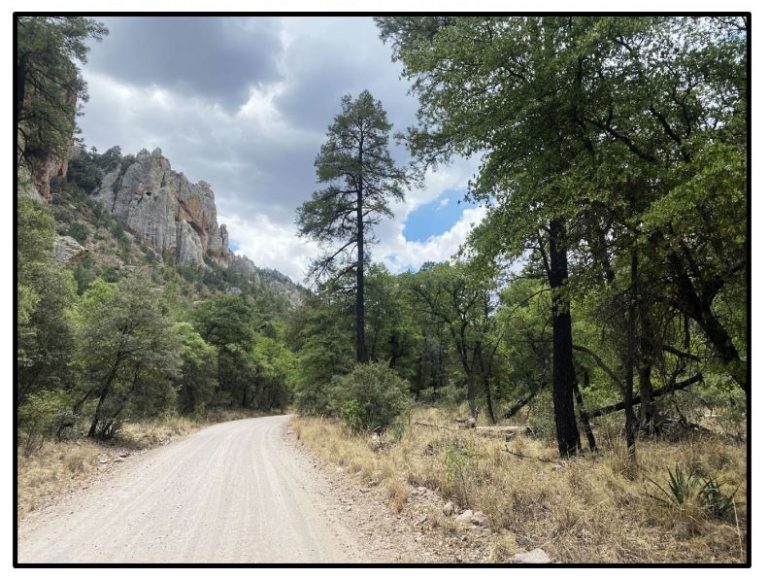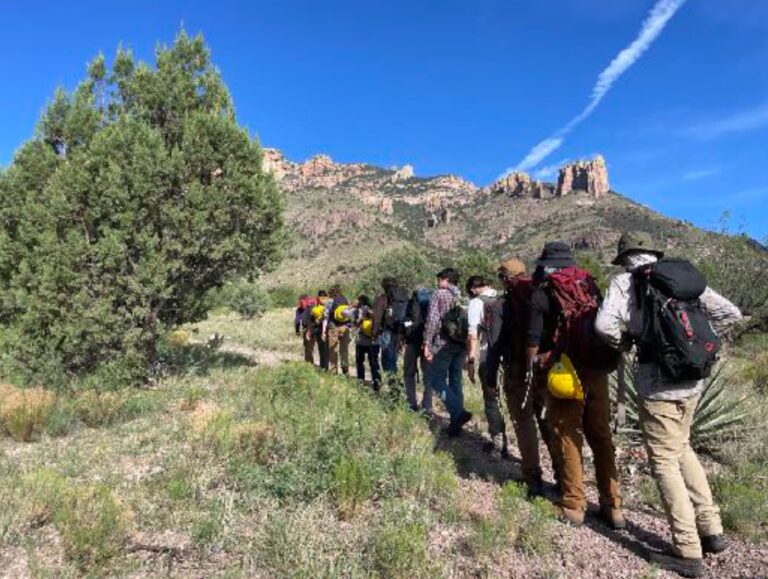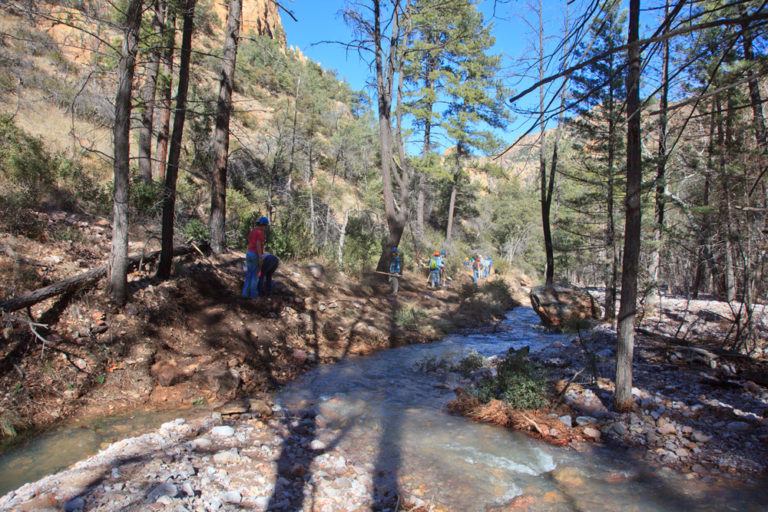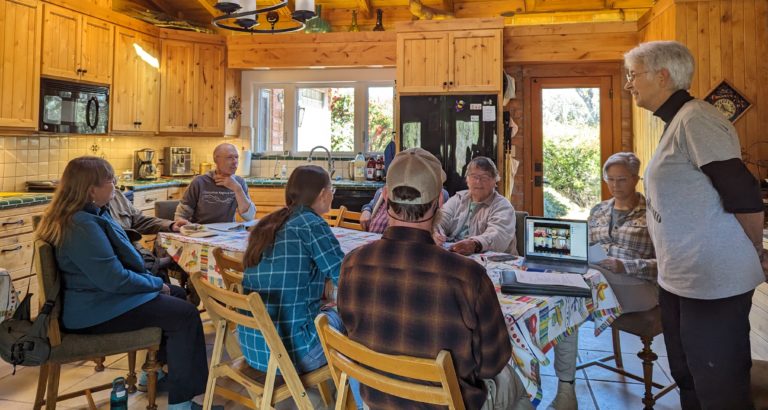CRC South Fork Day Use Area FEA objection
For your convenience, the full text of this is below as well.
Kerwin Dewberry, Forest Supervisor
Coronado National Forest
ATTN: Objections
300 W. Congress Street
Tucson, AZ 85701
objections-southwestern-coronado@fs.fed.us
July 30, 2021
Re: South Fork Day Use Area
The Chiricahua Regional Council, The Center for Biological Diversity, and Natural Allies, hereby submit this Objection to the U.S. Forest Service’s Draft Finding of No Significant Impact and Draft Decision Notice (Draft FONSI/DN) for “South Fork Day Use Area” on the Douglas Ranger District of the Coronado National Forest.
This Objection is filed pursuant to, and in compliance with, 36 C.F.R. Part 218, Subparts A and B. All parties to this objection have filed timely, specific and substantive written comments in accordance with 36 C.F.R. 218(a).
As required by 36 C.F.R. § 218.8(d), Objectors provide the following information:
- Chiricahua Regional Council is the Lead Objector for purposes of legal communication regarding the Objection. Please notify all additional parties via email of Objection hearings and Final Decision.
Wynne Brown – President
Chiricahua Regional Council
P.O. Box 16480
Portal AZ 85632
520-360-9392
wynne@wynnebrown.com
Robin Silver
Center for Biological Diversity
rsilver@biologicaldiversity.org
David Hodges
Natural Allies
dhodges73@gmail.com
The following individuals are Objecting and all submitted timely comments to the draft EA.
Walter Schoepfle
[email redacted]
Elaine Moisan
[email redacted]
Dodie Logue
[email redacted]
Bob Downs
[email redacted]
Linda Jakse
[email redacted]
Deborah Herczog
[email redacted]
Linda Wadsworth
[email redacted]
Shelli Vacca
[email redacted]
Albert Bammann
[email redacted]
Susan Dalby
[email redacted]
- The project that is subject to this Objection is the “South Fork Day Use Area” on the Douglas Ranger District of the Coronado National Forest.
- Objectors submitted extensive, timely, specific, and substantive comments during the Proposed Action Public Comment Period. All points and issues raised in this objection refer to issues raised in these documents, with the exception of new information bought forth in the Draft FONSI/DN, not found in previous analysis documents.
- In the following Statement of Reasons, Objectors provide the specific reasons why the decision is being appealed and the specific changes or suggested remedies that we seek, along with the related evidence and rationale on why the decision violates applicable laws and regulations.
The Proposed Action violates the Coronado National Forest Plan
The Proposed Action does not conform to numerous requirements found in the Coronado National Forest Land and Resource Management Plan, which provides management guidance for the South Fork Zoological and Botanical Area (SFZBA). The previous day-use site existed prior to the development of the1986 Coronado National Plan and was brought forward as a component of the 1986 Plan, with NEPA and other analysis being conducted during this previous planning process in the 1980s.
During the most recent forest planning process many existing facilities and management directives were brought forward from the 1986 Coronado National Forest Plan and were analyzed as a part of the new Forest Plan. A number of facilities and management components from the 1986 Forest Plan were modified or were not brought forward nor analyzed as components of the new Forest Plan. As such, these ceased to exist as a part of the Coronado National Forest’s future direction.
The Forest Service has incorrectly portrayed this project as reconstruction of an existing facility destroyed during Hurricane Odile. The proposed South Fork Day Use Area is new development in a new location almost a mile away from the historic location. The previous Forest Plan (1986) was specific in identifying the precise location of the allowed footprint of the Picnic Area:
“Recommend the designation of the South Fork of Cave Creek (outside the wilderness area) as a zoological-botanical area and portions of Guadalupe Canyon as a zoological area. A ten-foot wide strip along each side of the South Fork Road, around South Fork Picnic Area, and around the existing recreation residences will be excluded from this designation. They will be part of Management Area 3A. (page 83)” In reading this language it is clear the former picnic area existed in a specified location identified in the 1986 Forest Plan and continued to exist in that location for another 28 years.
In order for the existing picnic area to remain in its historic location in 1986, the Coronado National Forest felt a need to specifically identify an interior boundary for the picnic area that would not be a part of the originally proposed South Fork ZBA but contained within the ZBA.
The former day-use area located at a specific location within the South Fork ZBA was not brought forward as a component of the current Forest Plan. As such, it was not analyzed during the public planning process. What is contained in the current Forest Plan is a map of the South Fork ZBA (page 129), which does not depict a day-use area but only the ZBA in its natural state. The map also shows an area at the juncture of FR42 and South Fork Road, which was identified during the forest planning process as suitable for Developed Recreation.
There are numerous instances in the current plan where the updating of maps is discussed. According to the current Forest Plan, maps were updated with modern mapping techniques and errors were fixed. When updating the current map of the South Fork ZBA, the Forest Service identified an area along FR42 on the southern boundary of the ZBA as appropriate for development. The map did not identify any areas within the boundaries of the ZBA as suitable for development. This is the map you are bound by.
The Douglas Ranger District had a four-year period after Hurricane Odile to analyze rebuilding the previous day-use site under national forest planning regulations and to have this previous day-use area included in the current Forest Plan, but failed to do so. This area map, a description of the South Fork ZBA, non-site specific Desired Conditions for Special Areas, site specific Desired Conditions found within the Desired Conditions for the EMA, and two Standards which deal with Special Use Permits are the sum total of analysis and project identification found in the current 2018 Coronado Forest Plan.
Because the Douglas Ranger District and the Coronado National Forest failed to bring the previous day-use area into the current Forest Plan for analysis and public discussion, it does not exist as a component of the current forest plan. As such, the map found on page 129, as well as the Desired Conditions found in the current Forest Plan, are the guiding documents for the South Fork ZBA.
The proposed South Fork Day Use Area represents a second recreation hub within the ZBA, in addition to the Berm area. Prior to Hurricane Odile, there was a single recreation hub within the ZBA. If this were a rebuilding of a previously existing facility, it would be contained within the existing footprint of the destroyed facility (described in the 1986 Forest Plan) and it would not be proposed as a second recreation hub within the ZBA.
Degrees of impact differ in different locations. The Forest Service’s proposed site is almost a mile from the footprint of the previous site. Trees and other vegetation will be cleared to build at this new site, with the addition of new bathrooms and parking. Also, the new site is within the Post Fledging Area (PFA) of a Mexican Spotted Owl Protected Activity Center (PAC). It strains credibility to even suggest this is reconstruction of an existing site, which existed for 75 years and is almost a mile away.
The guidance found in the Forest Plan (2018) does not contemplate or support a recreational development project as has been proposed by the Douglas Ranger District. The plan states “Under the proposed action, the ZBA provides opportunities for solitude and challenge.”
In contrast, the Developed Recreation Land Use Zone (LUZ) provides for dispersed motorized and more-intensive recreation activities and development. The Forest Plan states the following in terms of what’s permitted in Developed Recreation LUZs, “facilities such as campgrounds and picnic areas provide a range of visitor needs; most areas have simple facilities like picnic tables and vault toilets, while some offer additional amenities such as paved roads, flush toilets, and recreational vehicle hookups.”
Desired Conditions for Special Areas is as follows: “All special areas are characterized by generally unmodified environments in which unique natural features are preserved. Each special area provides an example of one or more unique features within the Coronado National Forest. Scenic conditions are natural, unaltered, and wholly intact. Landscape character and sense of place are evident at the highest possible level. Research and monitoring activities do not disturb archaeological sites.
Research natural areas have excellent examples of the ecological features for which they were designated, with little evidence of human activity or disturbance. Visitor access and use occurs at environmentally acceptable levels to maintain the research values of the research natural area. Special use permits within these areas are inappropriate unless they are related to research for which the area is designated. Fire management mimics natural fire processes and is compatible with ongoing research.
Botanical areas protect the plants and plant communities for which they are designated. Plants and plant communities within these areas are resilient and are not negatively impacted by human activities. Nonmotorized recreation is allowed on a limited basis on designated trails to protect soil conditions and hydrologic flow. New trails are discouraged.
Zoological areas protect the unique wildlife and associated habitat for which they are designated. These areas contain unique or significant animals, animal groups, or animal communities, habitat, location, life history, ecology, environment, rarity, or other features.”
The South Fork ZBA is of national and international interest and should have a Management Plan that reflects its special values. As it is completely embedded within the larger Cave Creek Canyon Birds of Prey ZBA, a Management Plan should cover the entirety of the larger unit and both areas should be managed as one contiguous unit. Until such a Management Plan is developed, no development activities should occur within this area. In the absence of a Management Plan or any detailed site specific guidance in the Forest Plan, the Map found on page 129 of the Forest Plan becomes the specific guidance document for the South Fork ZBA. The area in which development can legally occur is clearly depicted on this map as Recreation Development Land Use Zone and is at the juncture of FR42 and South Fork Road.
Impacts to Mexican Spotted Owls
The proposal does not properly address potential impacts on the Mexican Spotted Owl (MSO) as the geographic location of the proposed Day Use Area is directly adjacent to a Mexican Spotted Owl Protected Activity Center (PAC), and this Day Use Area will increase human impacts on the PAC, not decrease them. The proposed Day Use Area lies only a few yards from locations where CRC personnel have observed and photographed fledgling MSOs in multiple years and is clearly an important area used by the fledgling owls. At the present time, human impacts on the Mexican Spotted Owl PAC are not great because they are limited almost entirely to the modest road traffic through the PAC, and few users of the canyon stop and hike off-road in this area. Most human users simply drive through the area on the way to favored locations near the end of the road, and most hikers confine their travels to the road itself. This level of use has evidently always been compatible with needs of the owls and has never before demanded road closure.
However, creation of a Day Use Area within the PAC will substantially increase human traffic both along the road and in off-road areas in the vicinity, resulting in habitat degradation and increased interactions of the owls with people. The owls have only limited foraging habitat in the canyon bottom, and this increased human traffic can surely be expected to impact the ecology of the owls in a significantly negative way just through vegetation trampling. The Recovery Team for the Spotted Owl has called special attention to needs of the species for high-quality riparian habitat.
Proposed closure of the road can be expected to be especially harmful, not helpful, for the owls because during the closure period the use of the area surrounding the Day Use Area can be expected to greatly increase, as many people will stay right at the Day Use Area instead hiking farther up the canyon. In addition, many people desiring to use areas farther up the canyon (perhaps the great majority of users) will now have to walk through the PAC to get there instead of driving through, and this will occur in the owls’ breeding season. Some of this increased foot traffic will surely be tempted into off-road excursions.
Social and Seasonal Aspects of South Fork Road Closure
Seasonal closure of the South Fork Road can be expected to have both beneficial and harmful aspects. On the positive side, there will presumably be reduced dust pollution, road hazards, and vehicle noise, all of which can be expected to enhance the nature experiences and safety of users in the road vicinity.
Perhaps the most negative social impact of the closure will be to deny access to much of the canyon for the many elderly users who have traditionally used and valued these locations — simply because they can no longer hike the distances from the closure gate needed to get to the sites on foot. Remember, the most favored parts of the canyon for nature tourism are up near the end of the road and partway up the trail starting at the end of the road. Moreover, this proposed closure would happen at the very time when nature visitation is at its peak: the spring breeding season. This strategy can be expected to negatively impact, not only many elderly residents of the immediate vicinity, but also the largely elderly clientele of the many nature tours that visit the canyon at just this time of year.
Problems with greatly reduced access posed by closure could be partially addressed by allowing vehicle access permits for physically challenged and elderly users, as well as cabin owners and cabin visitors, and perhaps other user groups, although this would pose some practical challenges in administration and fairness. People who might be negatively affected by closure are not limited to the above groups and demands for vehicle access may well develop in many other users for a variety of reasons (e.g., school classes, nature tours, etc.). Dealing successfully with such matters will demand administrative investments and policies not presently in place and will demand foresight and compliance in users not presently needed.
The magnitude of this problem is not addressed in the proposal, and maintaining a closure promises to be very difficult.
Timing of the proposed seasonal closure was aimed at the breeding season of a number of bird species, but this is also the same breeding season for many other wildlife species as well as the most attractive viewing season for nature enthusiasts. This situation poses apparent conflicts of interest with respect to timing of a closure—and one cannot avoid such difficulties by moving closure to another time of year. The benefits of closure with respect to dust pollution and road hazards would presumably be greatest during the heavy human use period in the spring. Yet this is exactly the same time of year where denied-access problems for elderly visitors would be most severe and most troubling for the Forest Service.
Remedies
- Do not build the Day Use Area as proposed. If the Forest Service feel the need for an additional picnic area in the Cave Creek/South Fork area, the Forest Service should work with All concerned community members to develop a plan that works for the community and forest visitors, as opposed to the Proposed Action, which has very little community or public support.
- One remedy would be to eliminate the seasonal closure altogether, which would avoid depriving some users of access, but of course it would not provide any benefits of dust reduction or road hazards reduction. Moving the closure period to some other part of the year might reduce some conflicts but would also reduce benefits and not provide any sort of plausible political solution to Spotted Owl and other avian conflicts.If a closure is deemed necessary, perhaps the most practical remedy would be for the elderly and other physically challenged individuals to apply for access permits online prior to visiting South Fork. This would be easy to administer via a gate code system. This strategy would have the benefit of reducing vehicle traffic on the road during breeding season, while providing access to those who would otherwise be unable to enjoy the full range of experiences found in this special area.
- Because of the many significant on-the-ground changes resulting from Hurricane Odile, a comprehensive planning process for the entirety of the Cave Creek Recreation Area is both crucially important and overdue.
- The Cave Creek Birds of Prey ZBA and the embedded South Fork ZBA subunit are areas of national significance and should have a Management Plan that focuses on their core ecological and cultural values and the retention of these values.
- Construction of a vault toilet and parking for two or three vehicles in the recommended Developed Recreation area at the intersection of FR 42 and South Fork Road would eliminate the need for port-a-potties at the berm.
Please let us know if you have any questions.
Sincerely,
Wynne Brown
Chiricahua Regional Council
P.O. Box 16480
Portal AZ 85632
Robin Silver
Center for Biological Diversity
David Hodges
Natural Allies
Walter Schoepfle
Elaine Moisan
Dodie Logue
Bob Downs
Linda Jakse
Deborah Herczog
Linda Wadsworth
Shelli Vacca
Albert Bammann

